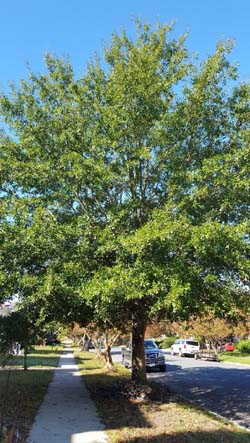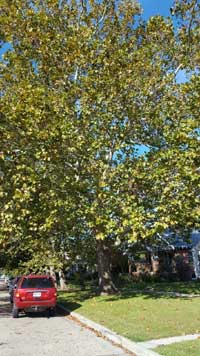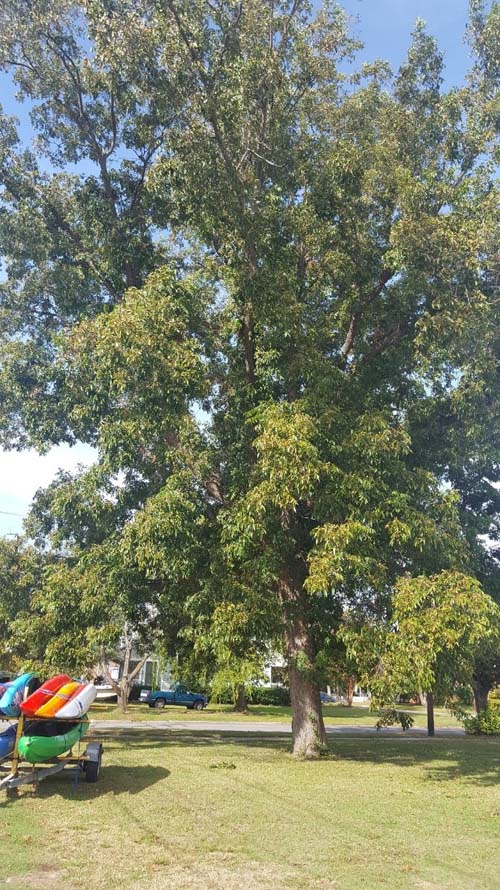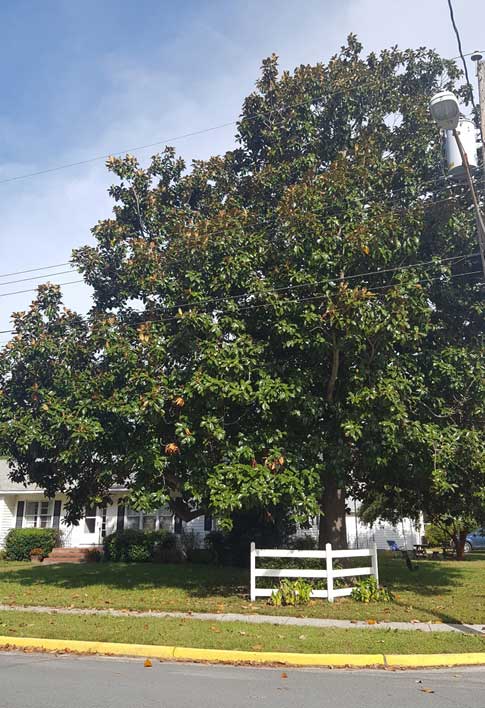Special report to the Mirror by Jane McKinley
In perusing the latest issue of A&N’s Cooperative magazine, my interest was drawn to an article featuring the Historic Garden Week on the Eastern Shore. One house, in particular, at 306 Bay Ave caught my eye with its “imposing position overlooking the Chesapeake Bay through 100-year-old ash trees.” This home is one of many in town which are graced with ancient trees, adding to the town’s distinctive character.

Water Oak, Tazewell Ave (Photo Jane McKinley)
Understanding the value of its beautiful trees, last year the Town of Cape Charles Historic Review Committee asked the Eastern Shore Master Naturalists to conduct an update to the 11-year-old Cape Charles Tree Survey. Perhaps you noticed teams of individuals walking around the historic district this past summer with notepads, measuring tapes and reference books in hand and their gaze perpetually looking up. They were taking extensive inventory of all the trees on each town lot, enumerating each including the lot location, the species, and the estimated height and diameter. This study will be used to reaffirm the town’s commitment to protecting and preserving our tree canopy. It will also increase public awareness about the condition of existing trees and provide recommendations for planting new trees in the Historic District.
Cape Charles is noted for its crepe myrtle lined streets as well as many old basswood, pecan, and sycamore trees from the early era of the town. In addition to these trees, the team found a wide variety of others, many of which are native to the area, such as maples, oaks and pecan. The results of their work include several tables of information identifying significant trees common to our area, unusual tree species for our area and distressed trees which have been brought to the attention of town management.
Among those trees common to our area, many are significant and identified as “signature trees.” As described in the 2006 Master Tree Plan, “signature trees are important community assets. They enhance the beauty of Cape Charles for its residents and guests. They protect property values and help draw tourists. Signature trees should be preserved when possible or replaced when removed.”
Among the list of signature trees is the bald cypress which is a native, pest free and well-shaped, one of which is in the 200 block of Randolph. The Basswood tree located across from the post office was singled out along with two others in town. These and three Red Oak trees, such as the one pictured here on Tazewell Avenue, are listed as significant signature trees. The Basswood and Oak trees also add value to wildlife. According to research by renowned entomologist Doug Tallamy, the mighty oaks are the “quintessential wildlife plants: no other plant genus supports more species of Lepidoptera [an order of insects that comprises butterflies and moths], thus providing more types of bird food.”
The list of unusual species trees includes a few Chinaberry trees on Randolph Avenue which, although healthy, like the Princess Tree in a vacant lot noted on Jefferson, is an invasive non-native. These are trees that we want to avoid planting since they do not support a diversity of wildlife and require higher maintenance.

Sycamores on Monroe (Photo Jane McKinley)
Although not native, the established trees on this list are striking. Five Cedar of Lebanon trees, including one located at the side of the post office, are a magnificent species. The one pictured here, located at 705 Monroe, is the grandest measuring 50 feet high and 30 feet wide. Other unusual species for are area included a blue spruce on Harbor, a Ginko on Monroe and a Pomegranate on Tazewell.
At the conclusion of their inventory, the Master Naturalist team made recommendations which are now under discussion with town leaders. Among their recommendations, they suggested developing a “list of preferred trees for home landscaping and for public area plantings that include trees that are native to the area, support wildlife and are climate tolerant. These trees should be planted where appropriate space is available for them to mature.” The list below provides suggested trees and shrubs that meet these guidelines. The 2006 Master Tree Plan also has listings of appropriate trees by type and location for streetscapes which are suggested by the Virginia Cooperative Extension of Virginia Tech. An excellent reference for native trees is the publication Native Plants of Accomack and Northampton which will be available for free at the Master Gardener table at the Cape Charles Farmers Market this summer.
They recommended that the town act to make citizens aware of the town’s trees, both notable trees as well as current policies on trimming, removing and planting new trees. They recommended the preparation of a pamphlet on our trees and key facts about our signature species trees to be made available at the welcome center and library. Let’s hope the town takes them up on these excellent recommendations!
For more information, a reference to landscaping and the management of trees can be found in the Historic District Review Board Guidelines page 66 and the “Tree Conservation and Preservation Ordinance,” Appendix F, Articles 1 and 11 of the Zoning Ordinance. Additionally, the results of the updated tree survey will be presented to Town Council at their regular meeting on the April 19.
NATIVE TREES AND SHRUBS RECOMMENDED FOR CAPE CHARLES LANDSCAPING
| Trees
|
Shrubs
|
| · Sweet Bay Magnolia | · Downy Serviceberry |
| · Red Bud | · Southern Arrow-wood Vibernum |
| · Sourwood | · American Beauty Berry |
| · Blue Ash | · Red Bay |
| · Beach plum | · Buttonbush |
| · Red Maple | · Inkberry |
| · Blackgum | |
| · Carolina Silverbell |

Pecan, Randolph Ave (Photo Jane McKinley)

Southern Magnolia,Madison Ave (Photo Jane McKinley)
Discover more from CAPE CHARLES MIRROR
Subscribe to get the latest posts sent to your email.
A great deal of thanks should go to the Master Naturalists who spent most of the summer and fall of 2017 to complete this survey. They are a small but dedicated group that are focused on the identification and preservation of the tree canopy in Cape Charles. They exceeded expectations and I can’t thank them enough.
I remember a tree in the 40s and 50s that stood far taller than anything else in town. When coming to Cape Charles by boat from the western shore you could see the tree on the horizon long before you could see the shore. It’s gone now, but it was a great navigation aid back then. Does anyone remember what kind of tree or when it came down?
It was an oak tree that was located in the New Roots Youth Garden. It died early last year from salt water intrusion and was cut down last spring. Much of the wood (including 10 -15 feet of the trunk) from the tree has been preserved and will be re-purposed in a way that will honor the tree.
Although planted extensively on the Shore and elsewhere, crepe myrtles are far from a native tree. At least they aren’t invasive as well.
Thanks for the credit, but I didn’t take the photos. This article was based on the Master Naturalists’ report to the Historic Review Board. Kudos to the Historic Review Board for recognizing the need and to the naturalists for conducting this comprehensive study. I can’t wait to see how the Town is going to use the information and recommendations.
Note: Thanks, we’ll adjust the photo credit as soon as we can!
looking forward to the results of the survey